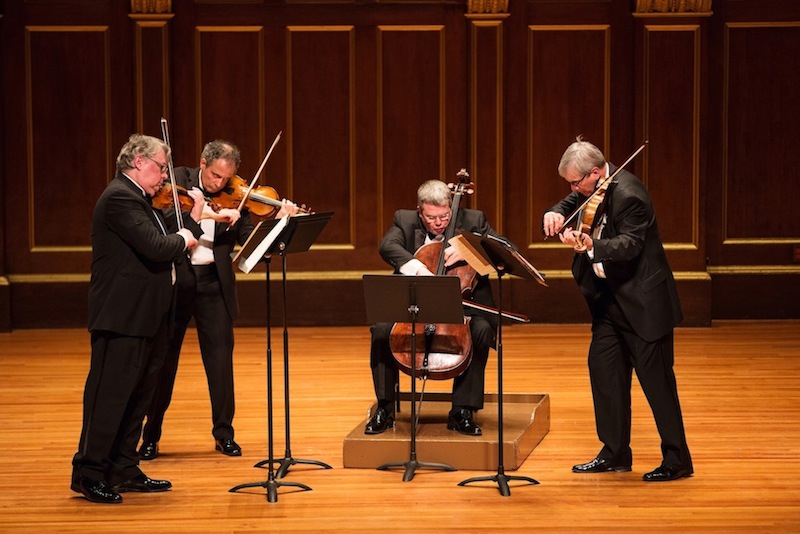Liebermann premiere makes powerful impact with Emerson Quartet
Few contemporary composers are performed as frequently as Lowell Liebermann. That is no doubt due to the probing, quasi-romantic qualities of his musical style, which make for enriching listening.
Liebermann’s latest work, his String Quartet No. 5, has been making concert rounds over the past few months. The Emerson String Quartet offered the work in its Boston premiere Thursday night as part of a wide-ranging program at Jordan Hall, a concert presented by the Celebrity Series.
Liebermann’s quartet is a marvel of a composition—-expertly crafted in one continuous movement yet written in a musical language that conveys a powerful emotional intensity. That is especially remarkable as the quartet has no explicit extra-musical program, though the composer stated in his program note that “its overriding elegiac tone [was] at least partly influenced by any number of depressing/ terrifying events of the kind with which we are all bombarded daily, in what seems like a world gone mad.”
The piece opened in darkness, with Emerson cellist Paul Watkins supplying a sturdy wave of scratching figures while violinists Eugene Drucker and Philip Setzer floated ghostly phrases overhead. Cutting through this glassy texture were the sounds of snapping strings and whistle tones, traded by Watkins and violist Lawrence Dutton. These sounds coalesced into earthy strains, with Drucker lofting a sorrowful melody over gliding figures played by Setzer and Dutton. Freely moving melodic gestures crept in to break up the measured phrases, the strings trading stirring lines that sounded as if an improvisation.
The fiery Scherzo bustles with energy, and the ensuing sharp-edged fugue unfolds in whip-crack passages that were punctuated by chords of biting dissonance. The final section recast the elements of the first in reverse order, the work ending in the same darkness from which it began.
Liebermann, who composed the work for the Emerson Quartet, made dexterous use of the ensemble’s unique sound, and the musicians delivered a bold and exacting reading. The Emersons play with a uniform tone and glossy blend. But their most impressive achievement involved their deft maneuvering between sweet, singing timbres to sounds of penetrating agitation in a veritable color-wheel of effects
Those qualities were also apparent in the music that opened the concert, a selection of works by Henry Purcell.
Of those, the Chacony in G minor, arranged for strings by Benjamin Britten, featured the Emersons in some of their most sensuous playing of the evening. The musicians found the full range of the piece, rendering the singing upper lines with glistening tone and mining the work’s melancholy with amber-rich phrases.
Two of Purcell’s Fantasias heard Thursday evening, No. 8 in D minor and No. 11 in G major, sounded with characteristic Baroque flair. Both of these works involve delicate, even quicksilver contrapuntal lines, which the Emersons traded between one other with grace.
But it was the ensemble’s mastery of timbre that made these short works such a pleasure to hear. The quartet rendered the music with an almost hollow tone that captured, to good effect, the sound of viols, for which the pieces were originally scored.
The second half of the concert was dedicated to Beethoven’s String Quartet in A minor, Op. 132, one of the composer’s most personal chamber works.
Much of the piece’s intimacy and emotional immediacy comes in the third of its five movements, a hymn to God, penned after the composer recovered from a painful intestinal inflammation. In addition to the hymn’s heavenly Lydian-mode strains, the movement is filled with lovely singing passages that are spaciously scored among the four instruments. The Emersons gave the movement a prayerful reading, the phrases unfolding in soft, glowing sheets of sound.
Elsewhere, the Emersons traversed the sudden shifts in mood and handled the dynamic shading of the first movement with fine control. The second movement, played with emphasis on the “ma non tanto” of its marked Allegro, had the airs and graces of a minuet. The fourth-movement march was given appropriate bounce, and the finale sounded with the gusto of a folk dance.
The next Celebrity Series event will feature mezzo-soprano Anne Sofie von Otter and pianist Angela Hewitt in songs and piano works by Beethoven, Schubert, Brahms, Fauré, Chabrier, Chaminade, and Debussy 8 p.m. Friday at Jordan Hall. celebrityseries.org; 617-482-2595
Posted in Performances





